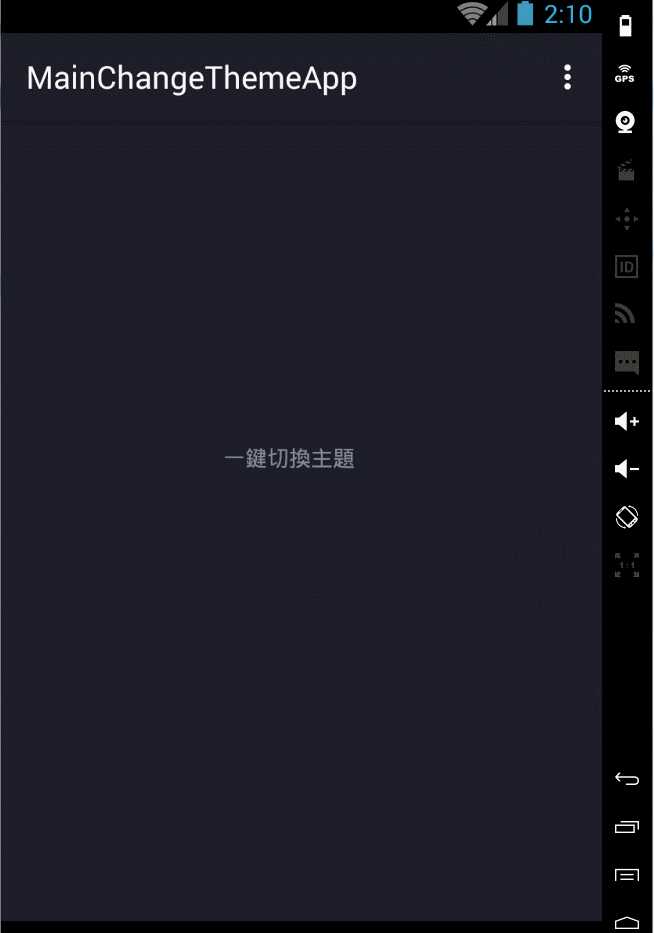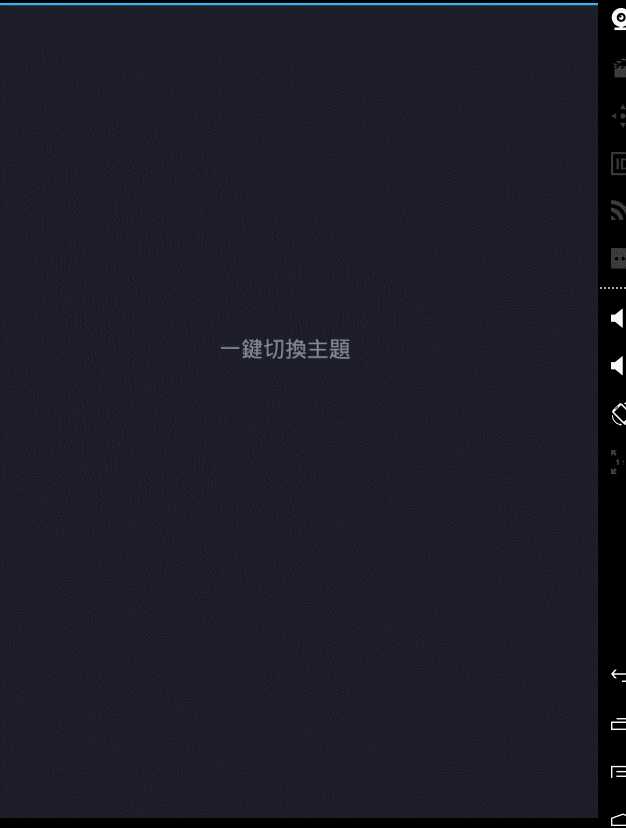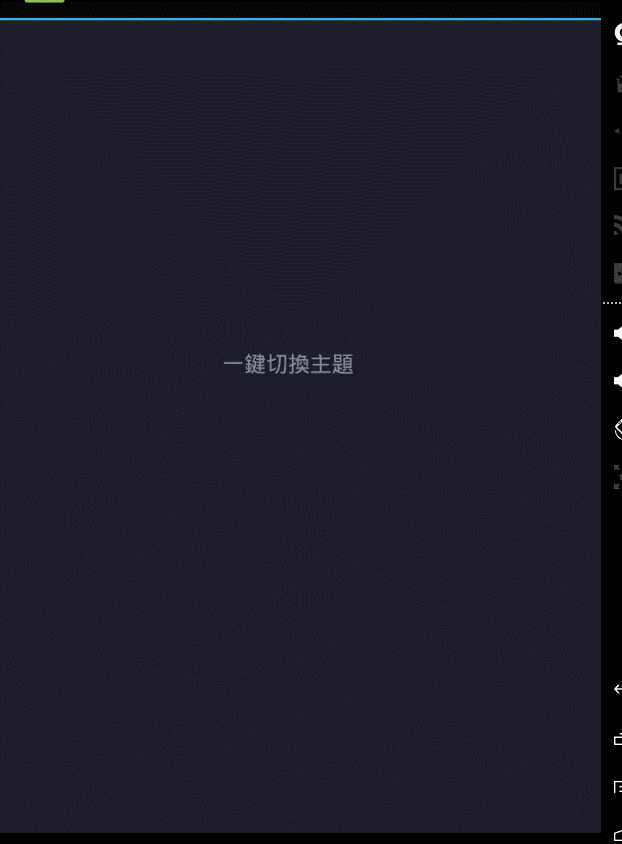标签:
首先来个最简单的一键切换主题功能,就做个白天和晚上的主题好了。
先看我们的styles文件:
1 <resources> 2 3 <!-- Base application theme. --> 4 <style name="AppTheme" parent="Theme.AppCompat.Light.DarkActionBar"> 5 <!-- Customize your theme here. --> 6 <item name="colorPrimary">@color/colorPrimary</item> 7 <item name="colorPrimaryDark">@color/colorPrimaryDark</item> 8 <item name="colorAccent">@color/colorAccent</item> 9 </style> 10 <style name="AppTheme.NoActionBar"> 11 <item name="windowActionBar">false</item> 12 <item name="windowNoTitle">true</item> 13 </style> 14 <style name="AppTheme.AppBarOverlay" parent="ThemeOverlay.AppCompat.Dark.ActionBar" /> 15 <style name="AppTheme.PopupOverlay" parent="ThemeOverlay.AppCompat.Light" /> 16 17 <!--白天主题--> 18 <style name="dayTheme" parent="AppTheme"> 19 <item name="android:textColor">#525252</item> 20 <item name="android:background">#f7f7f7</item> 21 </style> 22 23 <!--夜间主题--> 24 <style name="nightTheme" parent="AppTheme"> 25 <item name="android:textColor">#868a96</item> 26 <item name="android:background">#1e1e2a </item> 27 </style> 28 29 30 </resources>
好,然后我们来看看主要activity
package com.example.administrator.mainchangethemeapp;
import android.content.SharedPreferences;
import android.os.Bundle;
import android.support.design.widget.FloatingActionButton;
import android.support.design.widget.Snackbar;
import android.support.v7.app.AppCompatActivity;
import android.support.v7.widget.Toolbar;
import android.util.Log;
import android.view.View;
import android.view.Menu;
import android.view.MenuItem;
import android.widget.TextView;
public class MainActivity extends AppCompatActivity {
private TextView tv;
@Override
protected void onCreate(Bundle savedInstanceState) {
//sputils是對SharedPreferences的封裝,代碼就不上了,大家理解意思就行了
if(SPUtils.get(this,"theme","dayTheme").equals("dayTheme"))
{
//默認是白天主題
setTheme(R.style.dayTheme);
}else
{
//否则是晚上主題
setTheme(R.style.nightTheme);
}
super.onCreate(savedInstanceState);
setContentView(R.layout.activity_main);
tv=(TextView)this.findViewById(R.id.tv);
tv.setOnClickListener(new View.OnClickListener(){
@Override
public void onClick(View v) {
if(SPUtils.get(MainActivity.this,"theme","dayTheme").equals("dayTheme"))
{
SPUtils.put(MainActivity.this,"theme","nightTheme");
}else
{
SPUtils.put(MainActivity.this, "theme", "dayTheme");
}
recreate();
}
});
}
@Override
public boolean onCreateOptionsMenu(Menu menu) {
// Inflate the menu; this adds items to the action bar if it is present.
getMenuInflater().inflate(R.menu.menu_main, menu);
return true;
}
@Override
public boolean onOptionsItemSelected(MenuItem item) {
// Handle action bar item clicks here. The action bar will
// automatically handle clicks on the Home/Up button, so long
// as you specify a parent activity in AndroidManifest.xml.
int id = item.getItemId();
//noinspection SimplifiableIfStatement
if (id == R.id.action_settings) {
return true;
}
return super.onOptionsItemSelected(item);
}
}
然后来看下效果:

当然了,上面这个demo实际上是有缺陷的。有人会说了 你看人家新浪微博,那么多主题,你要是用这种方法,你这个app得有多大,
能做成微博那样要用什么就去下载什么么?答案是可以的。其实方案也很简单。
这种方案的思路就是,把主题包 额外做成一个apk,注意这个apk 是不会在桌面显示的。你只能在设置里的app列表里找到他。
然后在你的主activity里 取这个apk里的资源 即可。这里我也把这种方案的代码写一遍。注意下载apk 安装apk的代码我就不写了。
我们就假设 我们要切换的主题就是系统自带的主题就行了,我们的主activity 使用的是白天主题。然后我们的子app里面
为了简化代码,我们就不放自定义主题了,就使用android studio 原始的代码,一步步来,
先放上子app里的styles文件,其实这个里面一行代码都没更改,全是ide自己生成的:
1 <resources> 2 3 <!-- Base application theme. --> 4 <style name="AppTheme" parent="Theme.AppCompat.Light.DarkActionBar"> 5 <!-- Customize your theme here. --> 6 <item name="colorPrimary">@color/colorPrimary</item> 7 <item name="colorPrimaryDark">@color/colorPrimaryDark</item> 8 <item name="colorAccent">@color/colorAccent</item> 9 </style> 10 <style name="AppTheme.NoActionBar"> 11 <item name="windowActionBar">false</item> 12 <item name="windowNoTitle">true</item> 13 </style> 14 <style name="AppTheme.AppBarOverlay" parent="ThemeOverlay.AppCompat.Dark.ActionBar" /> 15 <style name="AppTheme.PopupOverlay" parent="ThemeOverlay.AppCompat.Light" /> 16 17 18 </resources>
然后就是子activity里的 配置文件manifest:
<?xml version="1.0" encoding="utf-8"?>
<manifest xmlns:android="http://schemas.android.com/apk/res/android"
package="com.example.administrator.sonproject" >
<application
android:allowBackup="true"
android:icon="@mipmap/ic_launcher"
android:label="@string/app_name"
android:supportsRtl="true"
android:theme="@style/AppTheme" >
<activity
android:name=".MainActivity"
android:label="@string/app_name"
android:theme="@style/AppTheme.NoActionBar" >
<intent-filter>
<action android:name="android.intent.action.MAIN" />
</intent-filter>
</activity>
</application>
</manifest>
注意这里
<category android:name="android.intent.category.LAUNCHER" />
的这行代码 我是没写的。这样就是保证在这个apk 安装好以后不会在桌面出现。
然后我们来看看主activity代码
1 package com.example.administrator.mainchangethemeapp;
2
3 import android.content.Context;
4 import android.content.SharedPreferences;
5 import android.content.pm.PackageManager;
6 import android.content.res.TypedArray;
7 import android.os.Bundle;
8 import android.support.design.widget.FloatingActionButton;
9 import android.support.design.widget.Snackbar;
10 import android.support.v4.app.Fragment;
11 import android.support.v7.app.AppCompatActivity;
12 import android.support.v7.widget.Toolbar;
13 import android.util.Log;
14 import android.util.TypedValue;
15 import android.view.View;
16 import android.view.Menu;
17 import android.view.MenuItem;
18 import android.widget.TextView;
19
20 public class MainActivity extends AppCompatActivity {
21
22 private TextView tv;
23
24 @Override
25 protected void onCreate(Bundle savedInstanceState) {
26 //sputils是對SharedPreferences的封裝,代碼就不上了,大家理解意思就行了
27 if (SPUtils.get(this, "theme", "dayTheme").equals("dayTheme")) {
28 //默認是白天主題
29 setTheme(R.style.dayTheme);
30 } else {
31 //否则是晚上主題,這裡晚上主題我們就去加載我們晚上主題apk里的資源
32 int resourceId = getResourceId(getPackageContext(this, "com.example.administrator.sonproject"), "style", "AppTheme");
33 setTheme(resourceId);
34 }
35 super.onCreate(savedInstanceState);
36 setContentView(R.layout.activity_main);
37 tv = (TextView) this.findViewById(R.id.tv);
38 tv.setOnClickListener(new View.OnClickListener() {
39
40 @Override
41 public void onClick(View v) {
42 if (SPUtils.get(MainActivity.this, "theme", "dayTheme").equals("dayTheme")) {
43 SPUtils.put(MainActivity.this, "theme", "nightTheme");
44 } else {
45 SPUtils.put(MainActivity.this, "theme", "dayTheme");
46 }
47 recreate();
48 }
49 });
50 }
51
52 @Override
53 public boolean onCreateOptionsMenu(Menu menu) {
54 // Inflate the menu; this adds items to the action bar if it is present.
55 getMenuInflater().inflate(R.menu.menu_main, menu);
56 return true;
57 }
58
59 @Override
60 public boolean onOptionsItemSelected(MenuItem item) {
61 // Handle action bar item clicks here. The action bar will
62 // automatically handle clicks on the Home/Up button, so long
63 // as you specify a parent activity in AndroidManifest.xml.
64 int id = item.getItemId();
65
66 //noinspection SimplifiableIfStatement
67 if (id == R.id.action_settings) {
68 return true;
69 }
70
71 return super.onOptionsItemSelected(item);
72 }
73
74
75 /**
76 * 获取其他apk的context
77 * @param context
78 * @param packageName
79 * @return
80 */
81 public static Context getPackageContext(Context context, String packageName) {
82 try {
83 return context.createPackageContext(packageName, Context.CONTEXT_INCLUDE_CODE | Context.CONTEXT_IGNORE_SECURITY);
84 } catch (PackageManager.NameNotFoundException e) {
85 e.printStackTrace();
86 }
87 return null;
88 }
89
90 //获取指定context的 type里面的 name属性
91 public static int getResourceId(Context context, String type, String name) {
92 return context.getResources().getIdentifier(name, type, context.getPackageName());
93 }
94 }
你看,到这里 我们就实现了,动态加载主题的方式了。当然了,到这里依旧是不完美的,因为settheme方法大家都知道一定要重启activity才有效啊。这样就不好了。
体验并非最佳。总是给人很突兀的感觉。而且我们都知道重启activity的成本很大。要考虑很多生命周期之类的东西。那我们继续往下看,看看有什么比较好的解决方案能解决这个问题。
首先 我们可以考虑一下这个问题,所谓的切换主题 之类的,无非就是把你那些控件的 背景色啊 字体颜色之类的 改变了一下。对于一个app来说,用户一般只有一个界面 会有切换主题的这个入口,
换句话说,我们的app里面 只有这一个activity 需要实现 不重启activity就切换 控件style的功能,其他activity我们是不需要实现这个功能的,因为再切换过去的时候基本上都会走oncreate。所以
我们只需要考虑这个 有切换主题按钮的 这个activity能实现 不重启activity就换皮肤的功能就可以了。其他activity不需要考虑。so 这样一想 这个功能就简单清晰了很多。
首先我们可以自定义2个属性,我们把他放在attrs 这个xml里面
1 <?xml version="1.0" encoding="utf-8"?> 2 <resources> 3 <!-- 首先自定义属性,这里我们为了简便 只自定义了这2种属性,如果你要自己做的话 看需求可以增加属性--> 4 <!-- 另外注意我们这里并没有使用declare-styleable 来包裹这里的2个属性 好处就是在xml文件里 不用另外定义前缀了--> 5 <attr name="custom_background" format="reference|color"/> 6 <attr name="custom_textcolor" format="reference|color"/> 7 </resources>
然后我们去定义一下我们的主题:
1 <resources> 2 3 <!-- 这里就设置2个最简单的 主题就行了,--> 4 <!--白天主题--> 5 <style name="dayTheme" > 6 <item name="custom_background">#f7f7f7</item> 7 <item name="custom_textcolor">#525252</item> 8 </style> 9 10 <!--晚上主题--> 11 <style name="nightTheme"> 12 <item name="custom_background">#1e1e2a</item> 13 <item name="custom_textcolor">#868a96</item> 14 </style> 15 </resources>
然后我们来写一下mainactivity的xml布局文件,我们假设这个布局是非常简单的:
1 <?xml version="1.0" encoding="utf-8"?> 2 <com.example.administrator.mainchangethemeapp.ThemeRelativeLayout xmlns:android="http://schemas.android.com/apk/res/android" 3 android:layout_width="match_parent" 4 android:layout_height="match_parent" 5 android:background="?attr/custom_background" 6 android:id="@+id/mainview" 7 > 8 9 <com.example.administrator.mainchangethemeapp.ThemeTextView 10 android:id="@+id/tv" 11 android:layout_width="100dp" 12 android:layout_height="100dp" 13 android:layout_centerInParent="true" 14 android:text="一鍵切換主題" 15 android:background="?attr/custom_background" 16 android:textColor="?attr/custom_textcolor" 17 /> 18 19 </com.example.administrator.mainchangethemeapp.ThemeRelativeLayout>
你看这个布局里面 就一个relativelayout和一个textview。 和以前xml唯一的区别就是这里backaground和textcolor使用的值 是我们前面定义好的属性了(但是要注意 这属性是没有值的 赋值的操作放在java代码里实现)。同时这2个控件 也并非是系统控件 而是自定义控件。然后我们看看这个自定义控件是怎么写的。注意我这里就做了2个自定义控件,如果你们的那个切换主题的入口页面里面有其他控件的话,就要学着下面的方法 自己拓展一下了,其实也很简单的。
首先呢,我们来定义一个接口,谁实现了这个接口 就说明这个控件可以不启动activity直接换肤!
1 package com.example.administrator.mainchangethemeapp;
2
3 import android.content.res.Resources;
4 import android.view.View;
5
6 /**
7 * Created by Administrator on 2015/11/14.
8 */
9 public interface ThemeUIInterface {
10
11 public View getView();
12 public void setTheme(Resources.Theme themeId);
13 }
然后我们来看看2个自定义控件怎么写:
1 package com.example.administrator.mainchangethemeapp;
2
3 import android.content.Context;
4 import android.content.res.Resources;
5 import android.util.AttributeSet;
6 import android.util.Log;
7 import android.view.View;
8 import android.widget.RelativeLayout;
9
10 /**
11 * Created by Administrator on 2015/11/14.
12 */
13 public class ThemeRelativeLayout extends RelativeLayout implements ThemeUIInterface{
14
15 private int attr_background = -1;
16
17 public ThemeRelativeLayout(Context context) {
18 super(context);
19 }
20
21 public ThemeRelativeLayout(Context context, AttributeSet attrs) {
22 super(context, attrs);
23 this.attr_background =ViewAttributeUtil.getBackgroundAttibute(attrs);
24 }
25
26 public ThemeRelativeLayout(Context context, AttributeSet attrs, int defStyleAttr) {
27 super(context, attrs, defStyleAttr);
28 this.attr_background =ViewAttributeUtil.getBackgroundAttibute(attrs);
29
30 }
31
32
33 @Override
34 public View getView() {
35 return this;
36 }
37
38 @Override
39 public void setTheme(Resources.Theme themeId) {
40 if(attr_background!=-1) {
41 ViewAttributeUtil.applyBackgroundDrawable(this, themeId, attr_background);
42 }
43 }
44 }
1 package com.example.administrator.mainchangethemeapp;
2
3 import android.content.Context;
4 import android.content.res.Resources;
5 import android.util.AttributeSet;
6 import android.view.View;
7 import android.widget.TextView;
8
9 /**
10 * Created by Administrator on 2015/11/16.
11 */
12 public class ThemeTextView extends TextView implements ThemeUIInterface{
13
14 private int attr_drawable=-1;
15 private int attr_textColor=-1;
16
17 public ThemeTextView(Context context) {
18 super(context);
19 }
20
21 public ThemeTextView(Context context, AttributeSet attrs) {
22 super(context, attrs);
23 this.attr_drawable = ViewAttributeUtil.getBackgroundAttibute(attrs);
24 this.attr_textColor = ViewAttributeUtil.getTextColorAttribute(attrs);
25 }
26
27 public ThemeTextView(Context context, AttributeSet attrs, int defStyleAttr) {
28 super(context, attrs, defStyleAttr);
29 this.attr_drawable = ViewAttributeUtil.getBackgroundAttibute(attrs);
30 this.attr_textColor = ViewAttributeUtil.getTextColorAttribute(attrs);
31 }
32
33 @Override
34 public View getView() {
35 return this;
36 }
37
38 @Override
39 public void setTheme(Resources.Theme themeId) {
40 if (attr_drawable != -1) {
41 ViewAttributeUtil.applyBackgroundDrawable(this, themeId, attr_drawable);
42 }
43 if (attr_textColor != -1) {
44 ViewAttributeUtil.applyTextColor(this, themeId, attr_textColor);
45 }
46 }
47 }
看上去 其实也蛮简单的对吧,无非就相比传统控件,他对外暴露了 setTheme这个方法罢了,而这个setTheme方法 其实就做了一件事,调用系统自己的方法重新set那些属性罢了。
1 package com.example.administrator.mainchangethemeapp;
2
3
4 import android.content.res.Resources;
5 import android.content.res.TypedArray;
6 import android.graphics.drawable.Drawable;
7 import android.util.AttributeSet;
8 import android.util.Log;
9 import android.widget.ImageView;
10 import android.widget.TextView;
11
12 public class ViewAttributeUtil {
13
14 public static int getAttributeValue(AttributeSet attr, int paramInt) {
15 int value = -1;
16 int count = attr.getAttributeCount();
17 for(int i = 0; i <count;i++) {
18 if(attr.getAttributeNameResource(i) == paramInt) {
19 String str = attr.getAttributeValue(i);
20 if(null != str && str.startsWith("?")) {
21 value = Integer.valueOf(str.substring(1, str.length())).intValue();
22 return value;
23 }
24 }
25 }
26 return value;
27 }
28
29 public static int getBackgroundAttibute(AttributeSet attr) {
30 return getAttributeValue(attr , android.R.attr.background);
31 }
32
33
34 public static int getTextColorAttribute(AttributeSet attr) {
35 return getAttributeValue(attr, android.R.attr.textColor);
36 }
37
38 public static void applyBackgroundDrawable(ThemeUIInterface ci, Resources.Theme theme, int paramInt) {
39 TypedArray ta = theme.obtainStyledAttributes(new int[]{paramInt});
40 Drawable drawable = ta.getDrawable(0);
41 if(null != ci) {
42 (ci.getView()).setBackgroundDrawable(drawable);
43 }
44 ta.recycle();
45 }
46 public static void applyTextColor(ThemeUIInterface ci, Resources.Theme theme, int paramInt) {
47 TypedArray ta = theme.obtainStyledAttributes(new int[]{paramInt});
48 int resourceId = ta.getColor(0,0);
49 if(null != ci && ci instanceof TextView) {
50 ((TextView)ci.getView()).setTextColor(resourceId);
51 }
52 ta.recycle();
53 }
54
55 }
好,到这里 脉络就逐渐清晰了,我们就看看主activity里怎么写了:
1 package com.example.administrator.mainchangethemeapp;
2
3 import android.app.Activity;
4 import android.os.Bundle;
5 import android.view.Menu;
6 import android.view.MenuItem;
7 import android.view.View;
8 import android.widget.TextView;
9
10 public class MainActivity extends Activity {
11
12 private TextView tv;
13
14 private View view;
15
16 @Override
17 protected void onCreate(Bundle savedInstanceState) {
18 //这行代码千万不能漏掉,否则会报错的。因为你在xml里 的那些值 根本就没有实际的值,如果不在这里强制性的setTheme就直接报错了
19 //在实际使用中 我们当然可以把这个方法 放在baseactivity里面。我们这里默认主题就白天吧
20 setTheme(R.style.dayTheme);
21 super.onCreate(savedInstanceState);
22 setContentView(R.layout.activity_main);
23 //这个就是跟布局
24 view = this.findViewById(R.id.mainview);
25 tv = (TextView) this.findViewById(R.id.tv);
26 tv.setOnClickListener(new View.OnClickListener() {
27
28 @Override
29 public void onClick(View v) {
30
31 //这边逻辑没啥好说的 其实可以不需要看啊,就是白天就切换到黑夜 黑夜就切换到白天呗
32 if (SPUtils.get(MainActivity.this, "theme", "dayTheme").equals("dayTheme")) {
33 SPUtils.put(MainActivity.this, "theme", "nightTheme");
34 setTheme(R.style.nightTheme);
35 } else {
36 SPUtils.put(MainActivity.this, "theme", "dayTheme");
37 setTheme(R.style.dayTheme);
38 }
39 //这个方法就是实现不重启页面切换主题的
40 ThemeUiUtil.changeTheme(view, getTheme());
41 }
42 });
43 }
44
45 @Override
46 public boolean onCreateOptionsMenu(Menu menu) {
47 // Inflate the menu; this adds items to the action bar if it is present.
48 getMenuInflater().inflate(R.menu.menu_main, menu);
49 return true;
50 }
51
52 @Override
53 public boolean onOptionsItemSelected(MenuItem item) {
54 // Handle action bar item clicks here. The action bar will
55 // automatically handle clicks on the Home/Up button, so long
56 // as you specify a parent activity in AndroidManifest.xml.
57 int id = item.getItemId();
58
59 //noinspection SimplifiableIfStatement
60 if (id == R.id.action_settings) {
61 return true;
62 }
63
64 return super.onOptionsItemSelected(item);
65 }
66
67 }
然后看一下切换主题的方法是怎么做的:
1 package com.example.administrator.mainchangethemeapp;
2
3 import android.content.res.Resources;
4 import android.util.Log;
5 import android.view.View;
6 import android.view.ViewGroup;
7 import android.widget.AbsListView;
8
9 import java.lang.reflect.Field;
10 import java.lang.reflect.InvocationTargetException;
11 import java.lang.reflect.Method;
12
13 /**
14 * Created by Administrator on 2015/11/14.
15 */
16 public class ThemeUiUtil {
17 /**
18 * 切换应用主题
19 *
20 * @param rootView
21 */
22 public static void changeTheme(View rootView, Resources.Theme theme) {
23 //這裡邏輯很簡單 就是递归调用changeTheme-----递归调用setTheme了。
24 //注意 你们如果是listview也包含在里面的话 listview自定义实现接口的时候要稍微复杂一些,看你们需要不需要也刷新listview里的item了
25 //这里为了简单 我就不写那么复杂了,就这一个逻辑:先set自己的theme 然后遍历自己的子控件 逐一set
26 if (rootView instanceof ThemeUIInterface) {
27 ((ThemeUIInterface) rootView).setTheme(theme);
28 if (rootView instanceof ViewGroup) {
29 int count = ((ViewGroup) rootView).getChildCount();
30 for (int i = 0; i < count; i++) {
31 changeTheme(((ViewGroup) rootView).getChildAt(i), theme);
32 }
33 }
34 }
35 }
36
37
38 }
你看,到这里 我们不重启activity实现换肤的功能就基本实现了,当然要做的完美的话 还需要各位自己扩充一下 其他控件。但是思路都是一样的。

看到这里 有人仍然会说,你这个虽然没有重启activity,但是还是不好看呀,还是显的突兀了,能否做到知乎 android app那样 切换白天黑夜主题的时候 显的很柔顺呢。
答案是可以的,而且解决方案也比较简单。就是给个动画就完事了,在切换前 先保留一下 之前界面的bitmap 然后切换皮肤的的时候 把这个bitmap 显示出来以后 然后改变他的
alpha值 就可以了,当全部动画显示结束以后 把那些不需要的资源全部释放 就ok了!
来看下代码,这里就放出点击事件的代码了,其他地方与前面的代码一致:
1 {
2
3 //我们先取这个根布局的 bitmap缓存 这个实际上跟截屏是差不多的一个东西。
4 view.setDrawingCacheEnabled(true);
5 view.buildDrawingCache(true);
6 final Bitmap localBitmap = Bitmap.createBitmap(view.getDrawingCache());
7 view.setDrawingCacheEnabled(false);
8
9 //这边逻辑没啥好说的 其实可以不需要看啊,就是白天就切换到黑夜 黑夜就切换到白天呗
10 if (SPUtils.get(MainActivity.this, "theme", "dayTheme").equals("dayTheme")) {
11 SPUtils.put(MainActivity.this, "theme", "nightTheme");
12 setTheme(R.style.nightTheme);
13 } else {
14 SPUtils.put(MainActivity.this, "theme", "dayTheme");
15 setTheme(R.style.dayTheme);
16 }
17 //我们new出来的这个蒙版view --mengbanview 就把他放到跟布局view里面 并且让他充满 同时这个view的background就是截屏前我们的那个截图bitmap
18 final View mengbanView = new View(getApplicationContext());
19 mengbanView.setBackgroundDrawable(new BitmapDrawable(getResources(), localBitmap));
20 ViewGroup.LayoutParams params = new ViewGroup.LayoutParams(ViewGroup.LayoutParams.MATCH_PARENT, ViewGroup.LayoutParams.MATCH_PARENT);
21 ((ViewGroup) view).addView(mengbanView, params);
22 mengbanView.animate().alpha(0).setDuration(400).setListener(new Animator.AnimatorListener() {
23 @Override
24 public void onAnimationStart(Animator animation) {
25 //这个方法就是实现不重启页面切换主题的
26 ThemeUiUtil.changeTheme(view, getTheme());
27 }
28
29 @Override
30 public void onAnimationEnd(Animator animation) {
31 //动画结束的时候移出这个蒙版view 并释放bitmap
32 ((ViewGroup) view).removeView(mengbanView);
33 localBitmap.recycle();
34 }
35
36 @Override
37 public void onAnimationCancel(Animator animation) {
38
39 }
40
41 @Override
42 public void onAnimationRepeat(Animator animation) {
43
44 }
45 }).start();
46
47
48 }
最后来看下效果是否和知乎一样:

大功告成,看上去自然多了!
Android 实现切换主题皮肤功能(类似于众多app中的 夜间模式,主题包等)
标签:
原文地址:http://www.cnblogs.com/android-blogs/p/4968941.html